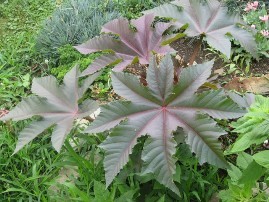Adaptation
Most of the current
adaptations that the castor bean currently has were bred in by
scientists looking to produce a better crop.
The vast majority of adaptations
were made by humans to result in a higher concentration of oil
 in
the seed. This was done so that they would yield a significantly
larger amount of oil for the same amount of crops.
in
the seed. This was done so that they would yield a significantly
larger amount of oil for the same amount of crops.
The most noticeable of all the
adaptations that didn't involve oil yield was the variations of seeds that are more adapted to
temperate climates. This
enables earlier planting and therefore, earlier crops.
It also allows the castor bean to be planted in non-tropical climates
unlike what the original castor beans in Africa and India.
Another noticeable adaptation was the production of the
shatter-resistant shell.
This allowed for a single harvest of the seed and resulted in a higher
yield. The shell was known to
shatter if it became too dry.
If the
The last adaptation I found wasn’t truly an adaptation of the seed
but of the way that they are harvested.
Mechanical harvesting was an excellent human adaptation brought
into the castor beans life.
This allowed farmers to have larger fields and thus resulted in larger
crops. The three most common
variations are Connor, Doughty 11 and Kentucky 38.
All of these varieties have a growing season of about 180 days,
and require about 15 to 20 inches of rainfall.
T
Back to Home To Multipleorganisms.net To UW-Lacrosse
